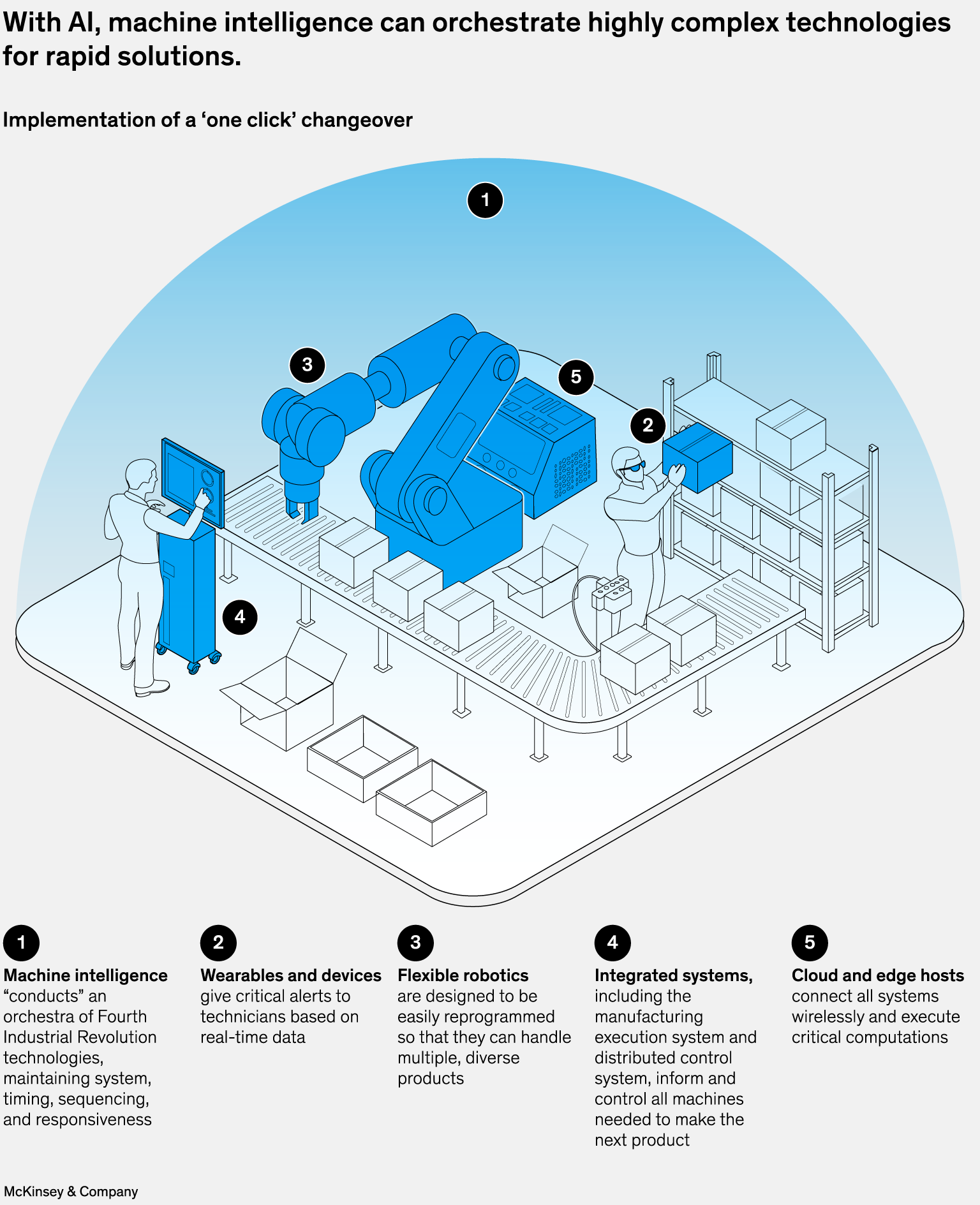The first article in this series explored the evolution of AI and how leading manufacturers have harnessed it to redefine the leading edge of manufacturing. It looked at the acceleration of the Fourth Industrial Revolution (4IR) from learning to doing. This second of three articles explores what AI looks like at the leading edge of manufacturing today. The final installment will explore the capabilities that the latest Lighthouses have built to deploy AI and other 4IR technologies with both speed and scale.
Lighthouses are the standard-bearers of manufacturing and supply chains. And increasingly, they are looking to AI to power their Industry 4.0 transformations. Whereas less than 20 percent of top use cases in the first three membership waves of the Global Lighthouse Network relied on AI technologies, now nearly 60 percent of the top use cases implemented by the 21 newest Lighthouses announced in December 2023 utilize AI (Exhibit 1). This comes as no surprise: AI-based use cases in this latest cohort alone have seen remarkable results, including a two to three times increase in productivity, a 50 percent improvement in service levels, a 99 percent reduction in defects, and a 30 percent decrease in energy consumption.

CITIC Pacific Special Steel, a special steel manufacturer in China, has identified dozens of applications for AI across its production process, including by predicting the inner workings of its blast furnaces to optimize process parameters in real time, increasing throughput by 15 percent while reducing energy consumption by 11 percent. Agilent, a life sciences equipment manufacturer in Germany, assetized its computer vision technology into a tool kit so effective that it enabled the deployment of five distinct computer vision use cases that reduced defect rates by 49 percent in just four months.
These technologies are maturing rapidly as companies improve the confidence intervals on AI’s predictions and recommendations. As belief in these models exceeds the confidence in planners or operators, factories such as Mondelēz’s baking facility in Beijing provide a glimpse into what this can look like, where frontline workers are more technicians than machine operators. Not only are they achieving more than two times the productivity improvements, but they are also seeing up to a 70 percent reduction in waste and 10 to 25 percent reductions in energy consumption.
If the rapid adoption of generative AI (gen AI) tools in banking and technology is anything to learn from, it’s likely that, for Lighthouses, at least, impact at a factory scale will be just around the corner. The knowledge, skills, and data foundations Lighthouses have built as they’ve moved past pilots for other 4IR technologies will likewise prove relevant for gen AI. This is true for ACG Capsules, a pharmaceuticals contract manufacturer in Pithampur, India, which fully developed and deployed a a copilot to interface with standard operating procedures (SOPs) in less than five weeks, achieving a 40 percent reduction in mean time to repair (MTTR) and, when paired with a virtual reality–enabled training solution, a nearly 40 percent reduction in technician onboarding time.
AI is advancing to impact quickly and is only speeding up. Manufacturers no longer need to ponder whether it’s possible or impactful. Lighthouses have already proved that. Instead, they need to focus on the risks, regulations, and complexities of responsible AI implementation—a critical topic worthy of its own publication. Lighthouses are not immune to these risks, and they have not been overly bullish. They have taken a measured approach, ensuring they have the expertise, systems, and leadership to reap the benefits of AI responsibly.
Together, the latest class of Lighthouses gives us five insights into what AI looks like at manufacturing’s leading edge (see sidebar “Lighthouses offer five insights into results-driven adoption of AI and gen AI”) and its role in the Fourth Industrial Revolution (see sidebars “Why AI is defining the Fourth Industrial Revolution” and “What is generative AI?”). This article will explore each insight in detail.
AI in every process
Early AI pilots focused on individual process steps, where the scope was smallest, risks were lowest, and iterations were fastest. Even today, more than 80 percent of Lighthouse use cases involving AI are likewise executed at the process step level. What’s notable, though, is that AI is having significant impact at every supply chain process step—including planning, asset management, quality, and delivery.
The most recent cohort of Lighthouses demonstrates this breadth and diversity. Consider planning, where Ingrasys deployed an AI-demand forecasting model that uses past data to train the model; in just three years, the changes have increased forecast accuracy by 27 percent. Or process optimization, where Hengtong Alpha Optic-Electric automatically optimizes preform and drawing parameters with a model trained on past strategies. Or quality, where VitrA Karo deployed computer vision in its kiln, which decreased the scrap rate by 68 percent. Or delivery, where China Resources Building Materials Technology has adaptively optimized heavy-transport equipment routes to decrease pickup lead times by 39 percent (Exhibit 2).

Democratizing AI with assetization
Achieving these impact levels—20 percent, 40 percent, or even 60 percent improvements across critical KPIs such as throughput, quality, and delivery performance—has required Lighthouses to scale past pilots and proof of concepts (POCs) to full implementation of use cases across every machine and production line. Some undertook their own four- or five-year journeys to pilot, learn, and scale new technologies and use cases. Others—such as CATL in Liyang, China; Unilever in Sonepat, India; and Johnson & Johnson in Xi’an, China—were able to leverage the learnings of their companies’ other Lighthouse sites to design for scale from day one. They applied advanced AI and other technologies across numerous processes, skipping the steep learning curve that the earliest Lighthouses had no choice but to overcome.
One of the ways that today’s Lighthouses have sped past pilots is with a strategic focus on “assetization”: that is, the art and science of packaging use cases for speed and scale of deployment. Other industries are also taking this approach: high AI performers are now 1.6 times more likely than other organizations to create AI applications using emerging low-code or no-code programs, allowing them to speed up the process of development even further.1
Would you like to learn more about our Operations Practice?
Lighthouses are already demonstrating how this approach works in the manufacturing sector. They are leveraging modular design principles to ensure interoperability with existing technology architecture. They are investing in—and then leveraging—deployment productivity tools such as no-code platforms for customizable interfaces. And they are including basic digital upskilling materials, such as walkthrough videos and SOPs, as part of the asset packages that they deploy, which are accessible to any user. This is how new use cases and digital innovations can go from being a localized tool to a company-wide asset that is used everywhere and tailored locally.
Agilent did exactly this. It built an in-house, ready-to-deploy AI solution library for detecting anomalies and responding to process deviations, bundling computer vision tools with plug-in connectors to manufacturing execution systems and test software, as well as packaging with SOPs, user documentations, and training guides for operators. This democratization of computer vision technology empowers technicians—not just engineers—to identify, deploy, and test new camera and vision applications end to end. This enabled Agilent to deploy five new applications across 57 work centers and 16 product lines, achieving a 49 percent defect rate reduction in less than four months.
On the horizon: Command centers for system-level automation
Smart homes don’t just build on centuries of progressively improving heating, cooling, lighting, and other technologies. They bring it all together with intelligent controls, automatically managing ambient temperatures, self-tending fireplaces, adjusting blinds, and obedience to vocal commands to play the perfect music or provide guidance on when to leave to catch the nearest subway. Smart factories are no different; their impact comes from similarly centralized intelligence with higher levels of decision-making capabilities—and placing their humans “on” the loop instead of “in” it.
Automating cognitive processes
Like physical automations, these cognitive automations come in stages. In the first, they apply intelligence to maintain steady-state operational processes, such as using AI to set process parameters in real time. Second, they (correctly) identify restorative actions—for instance, suggesting a corrective action for a machine underperformance or recommending a recipe adjustment to compensate for an input material impurity—with humans in the loop. Finally, they evolve to full “self-healing” manufacturing and supply chain operations, with humans on the loop.
Most Lighthouses have already achieved the first two. They are also accelerating toward the third—the technological achievement that underpins the concept of lights-out operations, where factories will achieve next-level improvements in productivity, quality, and service levels, and where the new front line will look more akin to augmented technicians than they will to the operators of today. Two new Lighthouses—Mondelēz and K-water—offer a look at this evolution (see sidebar “Command centers for cognitive automation: Two cases”).
Training for trust
In order to facilitate true system-level decision automation, AI not only needs to identify corrective actions—it is imperative that recommendations are trusted to be correct every time. This is true for all types of AI, including applied, generative, and others on the horizon. To address this, Lighthouses are prioritizing closed-loop feedback to improve their models and increase confidence intervals well before handing over control. They are also integrating safeguards, monitoring mechanisms and overrides for risk safety.
There are multiple ways to build trust with AI models—and this year’s Lighthouses exhibit several. One regularly retrains models on retroactive data, comparing past predictions with actual operator decisions and process performance, tuning until accuracy rates exceed that of humans. In another case, simulation can help; advanced techniques such as digital twins and AI-based simulation models can simulate the impact of recommended actions on metrics such as material availability, customer requirement matching, and machine uptime. This can rapidly improve the accuracy of cognitive decision making with a reduced need for experimentation. In a third case, models can be phased in—used first for human augmentation (that is, as a decision aid)—and their decisions can be given a probability score of being the same one made by a well-informed human. Operators can then vote on the recommendations, such as inventory replenishment levels or specific maintenance actions, to train and improve the models dynamically until they surpass the probability threshold, ready for true automation.
Gen AI innovations extend impact into the value chain
Generative AI is expected to add between $2.6 trillion and $4.4 trillion in annual value2 to the global economy—nearly a quarter of which could be captured by productivity improvements of up to two times and task automations of nearly 70 percent across manufacturing- and supply chain-related activities, primarily driven by new capabilities in content generation, insights extraction, and user interaction (see sidebar “Gen AI and engineering design: A hypothetical”).3
We are trying to use generative AI to help fresh engineers quickly learn those basic rules. Can we help engineers and college graduates, after half a year learning the [gen AI] tool, to become an independent designer?
Lighthouses have realized this potential and are bringing gen AI to areas where data is most unstructured. This includes areas of product development and procurement-related activities such as with Ni Jun’s vision for design advisers, people enablement with technician advisers, SOP-instructing chatbots, and personalized trainers, and in technology implementation with use cases such as software development copilots—one of gen AI’s most common implementations.
These kinds of use cases could enable robust digital transformations to happen faster than the two- to three-year sweet spot maintained by conventional wisdom. It’s no wonder then that 100 percent of new Lighthouses—known for their desire for speed and scale of I4.0—have at least one gen AI pilot under way; and some have more than five.
Speeding past pilots for gen AI, too
Back in 2019, when applied AI use cases were predominantly pilots and POCs, many factories were still building their data and technology foundations, ascertaining which new skills their workforces needed to have and developing strategies for successful implementation. At the time, the leadership from Lighthouses was in getting new use cases to real impact, even after potentially many pilots. But fast-forward to today, and Lighthouses are even further ahead, sometimes skipping pilots altogether. In fact, the time it takes new Lighthouses to implement new AI use cases has fallen by nearly 25 percent compared with earlier cohorts. This means that the starting line for emerging technologies such as gen AI is far more advanced than it was for applied AI five years ago.
ACG Capsules is a prime example of accelerated deployment of gen AI. Seeking to address the changing needs for employee skill sets in manufacturing, the company developed and deployed an SOP- and policy-interfacing gen AI assistant in just two weeks.
Within just five weeks, after some transfer learning and fine-tuning, the gen AI assistant was already being used by nearly three-quarters of operators and technicians to inform maintenance and compliance actions. As a result, ACG saw a 40 percent reduction in MTTR and unplanned downtime.
Lighthouse sites underscore the potential of AI in manufacturing, and Lighthouse companies are pressing the advantage they’ve built. Catching up will require fast followers to make quick, judicious moves to fill critical gaps—not only technological but also strategic and human. There’s no time to lose.
For more on the full World Economic Forum report upon which this article is based, see Global Lighthouse Network: Adopting AI at speed and scale, World Economic Forum, December 2023.
In the final article in this series, we will explore the six capabilities that Lighthouses have built to deploy AI with speed and scale.
The Global Lighthouse Network is a World Economic Forum initiative. The initiative was co-founded with McKinsey & Company and is counselled by an advisory board of industry leaders who are working together to shape the future of global manufacturing. The Advisory Board includes Foxconn Industrial Internet, Johnson & Johnson, Koç Holdings, McKinsey & Company, Schneider Electric and Siemens. Sites and value chains that join the network are designated by an independent panel of experts.




